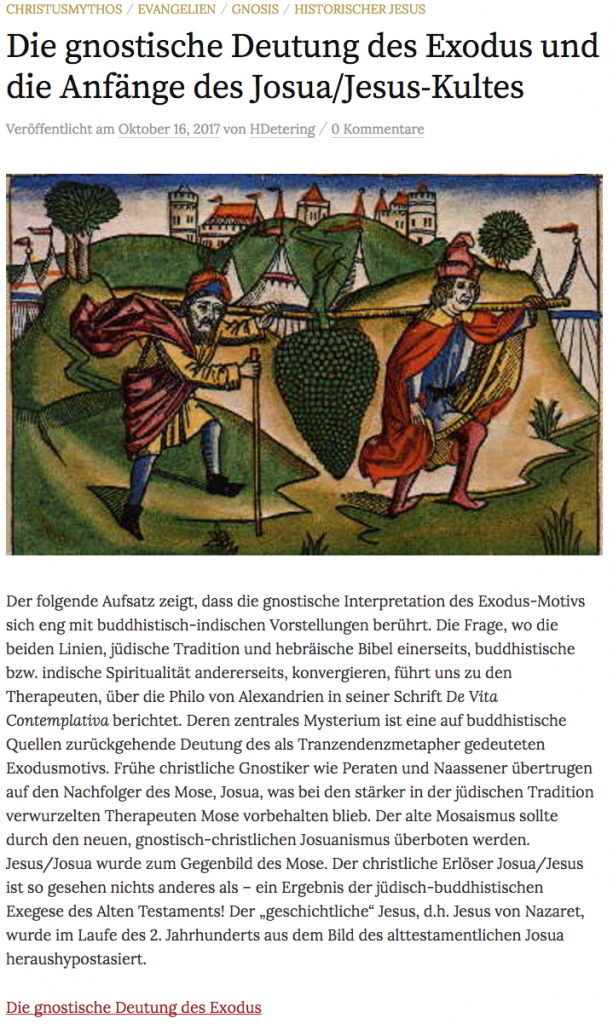Hermann Detering has a new essay (70 pages in PDF format) that will be of interest to many Vridar readers — at least for those of you who can read German. In English the title is The Gnostic Interpretation of the Exodus and the Beginnings of the Joshua/Jesus Cult.
See his RadikalKritik blog:
The work begins with reference to Philo’s allegorical interpretation of the Exodus and concludes with references to Buddhism. . . .
5 Zusammenfassung
Ausgehend von der gnostischen Interpretation des Exodus-Motivs und der Frage ihrer religionsgeschichtlichen Herkunft stießen wir auf die zentrale Bedeutung des als Transzendenzmetapher gebrauchten Bildes vom „anderen Ufer“, das in der indischen/buddhistischen Spiritualität eine erhebliche Rolle spielt. Die Frage, wo die beiden Linien, jüdische Tradition und hebräische Bibel einerseits, buddhistische bzw. indische Spiritualität andererseits, konvergieren, führte uns zu den Therapeuten, über die Philo von Alexandrien in seiner Schrift De Vita Contemplativa berichtet.
Nachdem die buddhistische Herkunft der Therapeuten plausibel gemacht wurde, konnte gezeigt werden, dass ihrem zentralen Mysterium eine auf buddhistische Quellen zurückgehende Deutung des Exodusmotivs zugrundeliegt. Diese Deutung enthält zugleich den Keim für das christliche Taufsakrament. Frühe christliche Gnostiker wie Peraten und Naassener übertrugen auf den Nachfolger des Mose, Josua, was bei den stärker in der jüdischen Tradition verwurzelten Therapeuten Mose vorbehalten blieb. Der alte Mosaismus sollte durch den neuen, gnostisch-christlichen Josuanismus überboten werden. Jesus/Josua wurde zum Gegenbild des Mose.
Der christliche Erlöser Josua/Jesus ist so gesehen nichts anderes als – ein Ergebnis der jüdisch-buddhistischen Exegese des Alten Testaments! Der „geschichtliche“ Jesus, d.h. Jesus von Nazaret, wurde im Laufe des 2. Jahrhunderts aus dem Bild des alttestamentlichen Josua heraushypostasiert.
Translators . . . . Where are you? We need you now!
If you enjoyed this post, please consider donating to Vridar. Thanks!


The Buddhist references found by Detering correspond in some way to my thesis that suggests a fusion between the Therapists of Alessandria and a sect of Tantric Buddhists coming from India.
In my last work, unfortunately only in Italian, the Marble Code, there is a precise hypothesis about the derivation of Gnostic Christianity from this fusion, whose traces are still detectable in the Gospel of Thomas.
The Buddhist connection is an interesting hypothesis. One can well understand the reluctance of many scholars to explore possible connections with Christianity, so it will be interesting to see what Hermann Detering has to say and to see what earlier studies he cites. I look forward to comparing that information with yours.
I look for the Detering’s hypothesis and in the meantime I will try to prepare a summary in English language of the elements that support a tantric connection that transformed a primitive Egyptian essene sect into a therapist.
5 Conclusion
Starting with the Gnostic interpretation of the Exodus motive and the question of its religio-historical origin, we arrived at the pivotal importance of the image of the „the further shore“ as a metaphor for transcendence, that plays an significant part in Indian/Buddhist spirituality. The question of where the two lines – Jewish tradition and Hebrew Bible on one hand, Buddhist or Indian spirituality on the other – converge, led us to the Therapeutae, about whom Philo of Alexandria writes in his work De Vita Contemplativa.
Having made to look plausible a Buddhist origin of the Therapeutae, it was possible to show that their main mystery is based on an interpretation of the Exodus motive that goes back to Buddhist sources. At the same time, that interpretation contains the germ of the Christian sacrament of baptism. Early Christian gnostics like Perates and Naassenes transferred onto Moses‘ successor Josua what the Therapeutae, more deeply rooted in Jewish tradition, preserved for Moses himself. The old Mosaism was meant to be surpassed by the new, Gnostic-Christian Josuanism. Jesus/Josua became the counterpart of Moses.
In this light, the Christian redeemer Josua/Jesus is nothing more than – a result of Jewish-Buddhist exegesis of the Old Testament! The „historical“ jesus, i.e. Jesus of Nazareth, was hypostasized from the Josua of the Old Testament in the course of the second century.
I’m sorry, my text editor changed every “of the” into “oft he”, and I didn’t realize it every time to change it back. Maybe a native English speaker might polish up my translation, so it can be posted in Neil’s original article.
Done.
Addenda/Corrigenda: by reading Detering’s article, I realized that “das andere Ufer” refers to the title of a book by Henri Le Saux, so it might be better to translate it accordingly as “the further shore” (not as the “opposite bank” as I did before).
Yours is still better than the Bing translator.
I’m not sure whether that’s a compliment … 😉
Hi Neil, I invite you to read this superb article by prof Droge, arguing for a legitimate suspicion that the original Joshua cult was without the theme of a death and resurrection of Jesus (which is the reason I am posting here, since Detering concluded his last essay with the words “It is clear that the idea of passion and resurrection was still alien to the original Jesus/Joshua cult”).
Read in this light, it is easy to see 1 Cor 1:23 as imposing the new story of a Roman crucifixion in order to eclipse the original idea of Jesus/Joshua as mythical revealer, and by reaction to 1 Cor 1.23, the interpolation of 1 Cor 2:6-11 as designed to make the same crucifixion a celestial crucifixion (in outer space) therefore itself the object of a mystical revelation. The idea of an heavenly revealer goes out the door (evidence: 1 Cor 1:13) and comes back in through the window (1 Cor 2:6-11).
I posted in reference to Droge’s earlier thought on the same theme at https://vridar.org/2021/05/11/celestial-or-earthly-christ-event-why-so-much-confusion-about-paul/.
See also http://vridar.org/2010/06/13/how-jesus-has-been-re-imaged-through-the-ages-to-fit-different-historical-needs/ for the different ways Jesus has been depicted through the ages.
Further, don’t overlook P-L. Couchoud’s discussion: https://vridar.org/2012/02/26/the-christ-of-johns-revelation-nemesis-of-pauls-crucified-christ/
(And René Salm is continuing his researches into this area.)